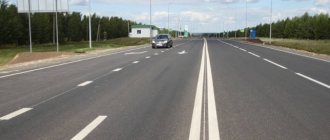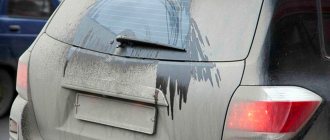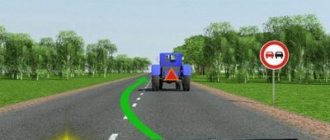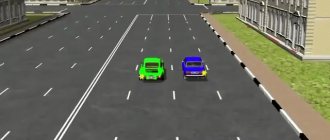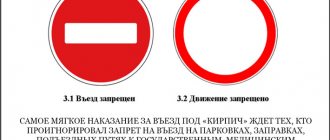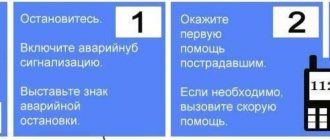Violations related to crossing road markings in the form of a solid line are a very common administrative violation.
Whether it is done intentionally or out of ignorance does not matter, the responsibility is the same, since it is strictly prohibited.
With this violation, there are many controversial situations; let’s further consider what they are and what fines are provided for this.
Before reading the article further, look at what road markings 1.1 look like.
Horizontal layout 1.1:
What is the fine for crossing marking 1.1 in one direction?
The set of provisions that regulates fines and other types of punishment for administrative offenses is regulated by the Code of Administrative Offenses of the Russian Federation.
According to part one of Article 12.16 of the Administrative Code, driving through a solid line in the same direction without complying with the requirements of road markings 1.1 entails a warning or a fine of 500 rubles .
For example . On a 4-lane road, the driver of a passenger car (A) decided to overtake a cargo vehicle (B) in front of the bridge. To the left of it is a horizontal marking 1.1, indicating the prohibition of crossing. Driver A crossed the solid marking line while passing! direction, but he committed this action in violation of traffic rules. Therefore, he will face punishment in accordance with Part 1 of Art. 12.16 Code of Administrative Offenses of the Russian Federation.
When turning through a solid lane 1.1 in order to change lanes in another direction from 1000 to 1500 rubles, Art. 12.16, part 2.
Crossing a continuous road according to the Code of Administrative Offenses
Such actions on the road can be considered one of the most common violations of the Rules. For crossing continuous markings, liability may arise under Art. 12.15 or art. 12.16 Code of Administrative Offences.
Article 12.15 of the Code of Administrative Offenses of the Russian Federation considers cases when a vehicle, ignoring a solid line, enters the oncoming lane and continues to move along it for some time:
- Part 4 of this article states that this violation is punishable by a fine of 5,000 rubles or deprivation of the right to drive a car for six months. At the same time, representatives of the traffic police, based on specific circumstances, can choose one type of punishment or another.
- It should be taken into account that in case of a repeated violation, the driver may lose his license for a period of one year (12.15 Code of Administrative Offenses of the Russian Federation, part 5).
- It is important to take into account that even if the driver crossed a solid marking, drove some distance along the oncoming lane, and then turned left, the same penalty is applied to him. For avoiding an obstacle while crossing a continuous line, in accordance with Part 3 of Article 12.15 of the Code of Administrative Offenses of the Russian Federation, a fine of 1000-1500 rubles is provided. There is a small clarification here in the form of the absence of corresponding signs.
Article 12.16 of the Code of Administrative Offenses of the Russian Federation describes a violation not related to driving in the oncoming lane:
- This happens when turning left or making a U-turn.
- Such violations also include leaving the yard or parking lot through solid markings.
These actions entail the imposition of an administrative fine in the amount of 1000-1500 rubles.
The main thing is to avoid driving in the opposite direction. If this is allowed, then Article 12.15 of the Code of Administrative Offenses of the Russian Federation comes into force.
What is written in the traffic rules?
In order to avoid warnings and fines for crossing a solid line in the same direction, you must strictly adhere to the Traffic Rules.
The main points of the traffic rules regarding the intersection of solid lanes:
- Clause 9.1(1). On any two-way roads, driving in the lane intended for the oncoming direction is prohibited if it is separated by tram tracks, a dividing strip, markings No. 1.1, 1.3 and 1.11.
- Clause 9.2. When driving two-way traffic on roads that have four or more lanes, when passing or overtaking, it is prohibited to enter the lane along which oncoming traffic is taking place.
Why do you need a solid line in front of a traffic light?
This markup appeared relatively recently. On some sections of the road, a continuous line 10-15 meters long is drawn in front of the traffic lights. This is, of course, related to ensuring road safety. After all, it’s no secret that some drivers like to change lanes before traffic lights and thus create an emergency situation.
Car owners do this in several cases:
- When they just remember at the last moment that they need to go in the other direction.
- And those who follow the drivers from the first point. They see that the car ahead suddenly starts flashing its turn signal and therefore are forced to go around it.
In any case, drivers have to maneuver in such a way that the car crosses the marking line. But is it worth issuing a fine for this?
Purpose of demarcation strips
Reference: demarcation stripes refer to horizontal road markings. Their main purpose can be judged directly by their name - this type of marking is designed to divide the road surface into lanes and zones.
Boundary strips include:
- Single continuous strip , its purpose is to separate traffic flows in opposite directions and mark the boundaries of traffic lanes in dangerous places on the roads. Indicates the boundaries of the roadway where entry is prohibited, and also demarcates parking spaces. In the traffic rules of the Russian Federation it is listed under number 1.1. It can be permanently white, temporary – orange. The latter is used during construction or repair work.
- A solid line in the same direction is a demarcation strip, which is usually applied to systematize the flow of vehicles in one direction. Such a line can be seen in tunnels, on bridges, when approaching an intersection.
- A double solid lane is used when there are more than 4 or more lanes on the road. In the traffic rules of the Russian Federation it is listed under number 1.3. Read about the driver's responsibility when crossing a double line in this article.
- A single solid stripe with a dotted line on the left side - to indicate places where changing lanes is allowed only on one side (No. 1.11).
- Thick solid strip - used to mark the edge of the roadway (No. 1.2). A solid line may also indicate the boundaries of the parking zone.
The photo shows markup 1.1:
Below is a photo of markup 1.3:
Below you can see a photo of the 1.11 markup:
Check out the photo of markup 1.2:
Horizontal marking 1.1 (single solid)
Road marking 1.1 is a single solid white line, 10 to 15 cm wide.
Using markup 1.1:
- Separates traffic flows in opposite directions (center line) on roads that have two or three lanes for traffic in both directions;
- Marks the boundaries of traffic lanes in dangerous places on the roads;
- Indicates the boundaries of the roadway into which entry is prohibited;
- Marks the boundaries of vehicle parking spaces.
It is prohibited to cross road markings (line) 1.1.
Errors when crossing a solid line
- Changing lanes in a different direction. A situation that occurs quite often on our roads. The driver, without waiting for an intersection or a turn, an intermittent line, hurries to change the direction of movement and crosses a solid line. Let us remind you that for such an act he will face a fine ranging from 1000 to 1500 rubles. according to Art. Code of Administrative Offenses 12.16, part 2.
- Attempt to overtake. The driver, neglecting traffic rules, overtakes, enters the oncoming lane and crosses the solid lane 1.1. For such a violation in accordance with Part 4 of Art. 12.15 Code of Administrative Offenses will be 5,000 rubles or deprivation of rights for crossing a continuous road for 4-6 months.
- An attempt to avoid an existing obstacle. Often, drivers encountering obstacles on the roads in the form of broken down cars, repair work, cross a continuous lane into the oncoming lane. This administrative violation is subject to punishment, which is regulated by Part 3 of Art. 12.15 Code of Administrative Offenses - a fine of 1000-1500 rubles.
Important: it doesn’t matter what is being crossed - a double and a single solid line are equivalent markings, the intersection of which is strictly prohibited.
Is it possible to cross a solid line at the curb?
The appearance of markings also led to the formation of a system of fines for non-compliance. Some drivers simply ignore the markings on the roads, especially when overtaking on the right to avoid traffic jams. And some, when they see a solid line at the side of the road, think that the same crossing rules apply to it as with markings separating traffic lanes in the center of the road.
What color is the line
Markings can be applied with the following paints:
- white – permanent marking accepted in all states;
- yellow - serves to indicate stops for minibus taxis, prohibits parking, and can also be used as a temporary one when carrying out any road work;
- red, orange - non-permanent markings applied with quickly erasable paints.
According to traffic rules, if a driver needs to stop urgently, he can cross the solid white line at the edge of the curb. If he drives off to the edge of the road and drives back without stopping, he will face a fine.
Areas marked with yellow lines warn that driving beyond the limit line is strictly prohibited, even if the car stops moving completely.
For your information!
Modern markings can be of two types: horizontal and vertical.
Penalty for crossing
For driving on the side of the road or driving off and stopping behind the yellow line limiting the road, a fine of 1,500 rubles is provided. The amount is fixed in Article 12.15, Part 1 of the Code of the Russian Federation on Administrative Offences. Traffic police officers often record traffic on the oncoming right side of the road in the form of overtaking several cars. With this interpretation, the driver already becomes a violator of Part 4 of this article. The fine increases to 5,000 rubles, and the situation may lead to the deprivation of a driver’s license for up to six months.
Controversial issues and ways to avoid punishment
The most common controversial situations, as well as ways to avoid punishment in them, are:
As we see, in many controversial issues it is possible, if not to completely avoid punishment, then to minimize the cost of fines. And if you pay within 20 days after receiving the decision, the driver will be able to count on discounts when paying the fine.
